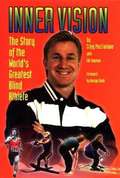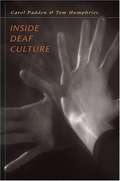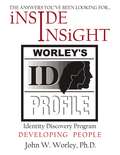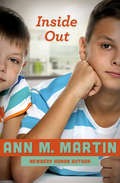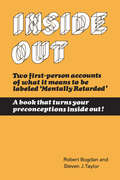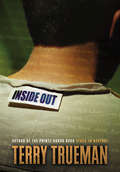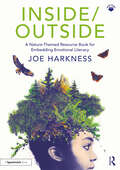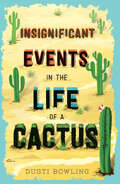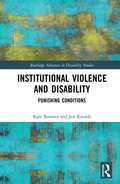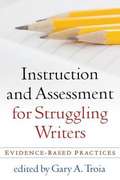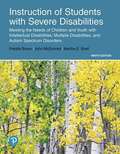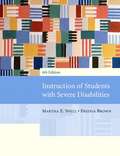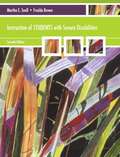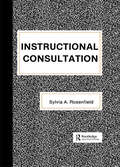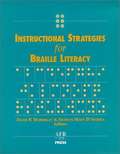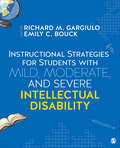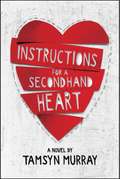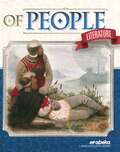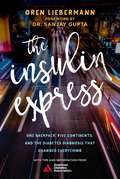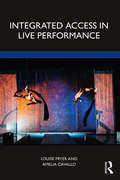- Table View
- List View
Inner Vision: The Story of the World's Greatest Blind Athlete
by Craig Macfarlane Gib TwymanCraig MacFarlane lost his sight at age 2 and went on to become not only the world's greatest blind athlete, but a much-sought-after motivational speaker. His message is PRIDE -- Perseverance, Respect, Individuality, Desire and Enthusiasm.
Inseparable: How Family and Sacrifice Forged a Path to the NFL
by Shaquem Griffin Shaquill Griffin Mark SchlabachMuch more than a sports memoir, in Inseparable Shaquem and Shaquill Griffin share the previously untold details of the powerful and inspiring story behind the modern NFL&’s first one-handed player, and his twin brother&’s unrelenting devotion, sacrifice, and love. It&’s the story of Shaquem&’s understanding of God&’s purpose for his life—to inspire others to stop being afraid and to stop making excuses—and his family&’s unwavering support in spite of seemingly insurmountable obstacles. The Griffins&’ unlikely underdog story has already captured the imagination of millions of football fans and physically challenged people around the world.
Inside Deaf Culture
by Carol Padden Tom Humphries<P>In this [account] of the changing life of a community, the authors of Deaf in America reveal historical events and forces that have shaped the ways that Deaf people define themselves today. Inside Deaf Culture relates Deaf people's search for a voice of their own, and their proud self-discovery and self description as a flourishing culture. <P>Padden and Humphries show how the nineteenth-century schools for the deaf, with their denigration of sign language and their insistence on oralist teaching, shaped the lives of Deaf people for generations to come. They describe how Deaf culture and art thrived in mid-twentieth-century Deaf clubs and Deaf theater, and they profile controversial contemporary technologies. <P> Most triumphant is the story of the survival of the rich and complex American Sign Language long misunderstood but finally recognized by a hearing world that could not conceive of language in a form other than speech. In a moving conclusion, the authors describe their own very different pathways into the Deaf culture, and reveal the confidence and the anxiety of the people of this tenuous community as it faces the future.
Inside Insight: Worley's Identity Discovery Profile (WIDP)
by John WorleyWho are you? Wouldn't you like to be authentic?&“INSIDE INSIGHT!&” By the time you finish reading this book, YOU will be a NEW PERSON!Most people have no idea what they want. Then again, for that matter, who they are. That is causing a world of hurt.The outcome from Dr. Worley is a ground-breaking psychometric assessment, Worley&’s ID Profile (WIDP). WIDP used with overwhelmingly positive reviews by corporate leaders, HR Departments, clinicians, churches, schools, sports teams, families, and individuals.In this book, Dr. Worley speaks about how he developed WIDP, why it is radically different from other profiling systems, and how you can use it to help align your outer persona and behavior with your inner expectations. WIDP concretely identifies what you "prefer and do not prefer from others.&” This crucial proof will help enhance your quality of life, and "You will see yourself on the pages of your profile.&”Having completed thousands of profiles I ALWAYS get responses like, &“WOW, how can you get this much information from those questions?&” or &“I can&’t believe how accurate this is about me!&” or &“I wish I had this information when I was younger!&” or &“I want to profile my whole family.&”Let&’s say you are one of those individuals that have always felt uncomfortable being around many people and don&’t like to socialize. GUESS WHAT? Most of society is like that! That is why no one talks on elevators or in doctor&’s offices. It just happens to be your unique temperament. It is &“OK&” for you to feel that way because that is who you are so, leave yourself alone and enjoy the recluse life. You are one of those people who live in their head, thinking, creating, dreaming and inventing ideas. Most people go through life not being able to identify with their true inner desires. You are one of a kind, unique person and that makes you very special.Then there is the temperament that has the innate desire always to be leading others, making decisions, and being in control. They are natural-born leaders and, like cream in milk, will always rise to the top of an organization. You are naturally gifted as a leader and have innate ability to lead armies. If you cannot lead where you are, you will move to another position. You will be anxious until you land in a governance spot. Once you find that position, you will be fulfilled.Then there are the peacemakers, servants, and cheerleaders! The peacemakers balance out everyone and maintain harmony. They are great arbitrators and have a comedy streak. The servants are loyal and committed to working until the task is completed. They are proficient and quiet. They are invaluable. The cheerleaders are the socialites who make the world exciting and fun. Without them, life would be boring. We need them, and they want all of us to be open to them and to be their friends. They are very colorful and expressive and, very open in their communications.We&’re different! Appreciate your temperament. You are VERY important!Expect miracles.
Inside Out
by Ann M. MartinHow do you love someone who makes you miserable? Eleven-year-old Jonathan just wants to have a normal life—for instance, a night when he isn&’t awakened by screams, or a day when he&’s not teased by other kids for having a disabled family member. But normal can&’t happen when your little brother is severely autistic.James, Jonathan&’s four-year-old brother, needs more help than his parents can give him. And it&’s not just hard for Jonathan—it&’s causing strife for the whole family. When James gets into a special school for autistic children, Jonathan and his sister have to make a lot of sacrifices so he can go. Jonathan comes up with an idea to help out the family—but will his plan work, or only lead to more teasing?This ebook features an illustrated personal history of Ann M. Martin, including rare images from the author&’s collection.
Inside Out: The Social Meaning of Mental Retardation
by Seymour B. Sarason Steven J. Taylor Robert Bogdan'We have to assume that the mind is working no matter what it looks like on the outside. We can't just judge by appearance...If you take away the label they are human beings.' Ed MurphyWhat does it mean to be 'mentally retarded'? Professors Bogdan and Taylor have interviewed two experts, 'Ed Murphy' and 'Pattie Burt,' for answers. Ed and Pattie, former inmates of institutions for the retarded, tell us in their own words.Their autobiographies are not always pleasant reading. They describe the physical, mental, and emotional abuses heaped upon them throughout their youth and young adulthood; being spurned, neglected, and ultimately abandoned by family and friends; being labelled and stigmatized by social service professionals armed with tests and preconceptions; being incarcerated and depersonalized by the state.Ed and Pattie survived these experiences--evidence, perhaps, of the indefatigable will of the human spirit to assert its essential humanity--but the wounds they have suffered, and the scars they bear, have not been overcome. They are now contributing, independent, members of society, but the stigma of 'mental retardation' remains.Their stories are both true and representative--powerful indictments of our knowledge of, our thinking about, and our ministrations to, the mentally handicapped. The interviewers argue that Ed and Pattie challenge the very concept of 'mental retardation.' Retardation, they assert, is an 'imaginary disease'; our attempts to 'cure' it are a hoax.Read Ed's and Pattie's accounts and judge for yourself.
Inside Out
by Terry TruemanIn a busy coffee shop, a robbery goes wrong. Two gunmen hold seven hostages, including teenager Zach Wahhsted. What nobody realizes at first is that Zach is anything but ordinary and his troubled mind is more dangerous than any weapon. Terry Trueman has created a compelling character with the same shocking power and heartbreaking compassion as his Printz Honor Award debut novel, Stuck in Neutral. Ages 12+
Inside/Outside: A Nature-Themed Resource Book for Embedding Emotional Literacy
by Joe HarknessInside/Outside is a unique educational resource for those working with young people of secondary school age, providing a variety of tried-and-tested indoor and outdoor lessons and activities to promote and embed emotional literacy. The book is divided into three accessible sections: emotions and feelings; self and situation; and mental health and wellbeing; which each cover a variety of themes, from anxiety and depression, to happiness, communication, and confidence. For each theme, ‘inside’ and ‘outside’ activities are offered, with inside activities inspiring students to self-reflect and develop empathy for others, and those outside drawing heavily on nature and learning outside the classroom. The ‘outside’ activities are adaptable and have been designed to work in any available outdoor space, and all activities can be used either in standalone lessons or sequentially, with introductory tasks, group activities, and circle time discussions. With a focus on equipping students with meaningful and tangible skills to support them in the recognition, identification, and expression of their emotions, Inside/Outside will be a valuable resource for teachers, youth workers, home-educators and anyone else looking to facilitate nature connection and introspection in children aged eleven to sixteen.
An Insider's Guide to Orthopedic Surgery: A Physical Therapist Shares the Keys to a Better Recovery
by Elizabeth Kaufmann Jared ForanNearly two million Americans undergo elective orthopedic surgery each year. And the numbers keep growing—hip replacements are projected to double over the next fifteen years, and knee replacements will quadruple. When you are ready for your procedure, you’ll want a copy of An Insider’s Guide to Orthopedic Surgery at your side. It is the only book that will help you prepare yourself (and your home) for a quicker and more thorough recovery. As a physical therapist who has spent more than seventeen years helping patients through recovery, author Elizabeth Kaufmann discusses the things that your surgeon won’t cover. You’ll get detailed, practical instruction on: • Preparing your home for the equipment you’ll need upon return • Understanding what will happen at every step of your hospital stay, from arrival through surgery to release (which will likely be sooner than you expect) • Getting the best care from therapists and other hospital and rehab staff members • Dealing with pain throughout the healing process • Building a support network to help provide care during recovery You’ll also learn the difference between a physical therapist and an occupational therapist; be ready for that first session; and find out the advantages of home therapy, sub-acute rehab, and outpatient therapy. If you have been suffering from chronic pain in the shoulder, knee, or hip, joint replacement can offer a second chance at restoring the life you desire. An Insider’s Guide to Orthopedic Surgery will help you get ready for it.
Insignificant Events in the Life of a Cactus (Life of a Cactus #1)
by Dusti Bowling&“Aven is a perky, hilarious, and inspiring protagonist whose attitude and humor will linger even after the last page has turned.&” —School Library Journal (Starred review) Aven Green loves to tell people that she lost her arms in an alligator wrestling match, or a wildfire in Tanzania, but the truth is she was born without them. And when her parents take a job running Stagecoach Pass, a rundown western theme park in Arizona, Aven moves with them across the country knowing that she&’ll have to answer the question over and over again. Her new life takes an unexpected turn when she bonds with Connor, a classmate who also feels isolated because of his own disability, and they discover a room at Stagecoach Pass that holds bigger secrets than Aven ever could have imagined. It&’s hard to solve a mystery, help a friend, and face your worst fears. But Aven&’s about to discover she can do it all . . . even without arms.Autumn 2017 Kids&’ Indie Next Pick Junior Library Guild Selection Library of Congress's 52 Great Reads List 2018
Institutional Violence and Disability: Punishing Conditions (Routledge Advances in Disability Studies)
by Kate Rossiter Jen Rinaldi"This was several times with that damn cribbage board. I hate cribbage boards to this very day. They never beat us on the arms or legs or stuff, it was always on the bottom of the feet, I couldn't figure it out." Brian L., Huronia Regional Centre Survivor Over the past two decades, the public has borne witness to ongoing revelations of shocking, intense, and even sadistic forms of violence in spaces meant to provide care. This has been particularly true in institutions designed to care for people with disabilities. In this work, the authors not only describe institutional violence, but work to make sense of how and why institutional violence within care settings is both so pervasive and so profound. Drawing on a wide range of primary data, including oral histories of institutional survivors and staff, ethnographic observation, legal proceedings and archival data, this book asks: What does institutional violence look like in practice and how might it be usefully categorized? How have extreme forms violence and neglect come to be the cultural norm across institutions? What organizational strategies in institutions foster the abdication of personal morality and therefore violence? How is institutional care the crucial "first step" in creating a culture that accepts violence as the norm? This highly interdisciplinary work develops scholarly analysis of the history and importance of institutional violence and, as such, is of particular interest to scholars whose work engages with issues of disability, health care law and policy, violence, incarceration, organizational behaviour, and critical theory.
Instruction and Assessment for Struggling Writers
by Gary TroiaThis unique book focuses on how to provide effective instruction to K-12 students who find writing challenging, including English language learners and those with learning disabilities or language impairments. Prominent experts illuminate the nature of writing difficulties and offer practical suggestions for building students' skills at the word, sentence, and text levels. Topics include writing workshop instruction; strategies to support the writing process, motivation, and self-regulation; composing in the content areas; classroom technologies; spelling instruction for diverse learners; and assessment approaches. Every chapter is grounded in research and geared to the real-world needs of in-service and preservice teachers in general and special education settings.
Instruction Manual for Braille Transcribing
by Constance Risjord Library Of Congress National Library Service for the Blind Physically Handicapped StaffThe courses leading to certification as a braille transcriber or proofreader have been administered by the National Federation of the Blind (NFB) under a contract with and on behalf of the National Library Service for the Blind and Physically Handicapped, Library of Congress (NLS).
Instruction Of Students With Severe Disabilities
by Fredda Brown John McDonnell Martha SnellIn this authoritative guide, leading scholars and researchers present information and evidence-based practices for dealing with the full range of curriculum and instruction for individuals with severe intellectual disabilities and autism. Case studies throughout Instruction of Students with Severe Disabilities look at students of various ages and with a variety of disabilities, and each chapter includes an application to a student with autism. The content is presented with citations of supportive research, and evidence-based practices are presented in clearly defined ways to ensure that teachers understand the practices and how to apply them in their own classrooms.
Instruction of Students with Severe Disabilities
by Martha E. SnellThis book examines the principles behind teaching students with severe and multiple disabilities. This edition includes a stronger focus on positive behavior interventions and supports, and additional strategies on peer relationships.
Instruction of Students with Severe Disabilities
by Martha E. Snell Fredda BrownThe seventh edition of this widely-adopted text for special educators addresses the full-range of curriculum and instructional topics involved in educating individuals with moderate, severe, and multiple disabilities. Evidence-based practices are presented in clearly-defined ways so that teachers can easily understand the research presented and apply it in the real classroom. All chapters in the book are unique, written by leaders in the field known for their research and writing on the specific topics. Case studies of students are applied to chapter content in vignettes, tables, and figures found throughout the chapters, and the textbook rests on a solid evidence-base with research citations provided. The new edition features many new updates including: a greater emphasis on teaching students with autism; six new chapters authored by experts in the field; more information on teaching methods supported by research, peer support, teaching academic skills, the process for planning and implementing instruction within general education classrooms, transition planning, and alternate assessment.
Instructional Consultation (School Psychology Series)
by Sylvia RosenfieldRecent changes in policy and law, along with advances in research, are making it necessary for an increasing number of school psychologists, special educators, and teacher consultants to develop skills in areas other than psychoeducational assessment. In response to this need, many professionals and students are expanding their careers to include the field of instructional consultation -- the synthesis of school- based consultation techniques and a solid knowledge of effective instructional practices. This book examines the major themes of instruction and gives a step-by-step outline of the consultation process from referral to the final report. Recent changes in policy and law, along with advances in research, are making it necessary for an increasing number of school psychologists, special educators, and teacher consultants to develop skills in areas other than psychoeducational assessment. In response to this need, many professionals and students are expanding their careers to include the field of instructional consultation -- the synthesis of school- based consultation techniques and a solid knowledge of effective instructional practices. This book examines the major themes of instruction and gives a step-by-step outline of the consultation process from referral to the final report.
Instructional Strategies for Braille Literacy
by Diane P. Wormsley Frances M. D'AndreaOffers instructors specific, practical strategies for the teaching of Braille reading and writing. Chapters discuss general guidelines and strategies; fostering emergent learning; making the transition from print to Brail teaching Braille to students with special needs, and to students who speak English as a second langua assessing the literary skills of students who are blind or visually impaired; and technology and Braille. Annotation copyrighted by Book News, Inc. , Portland, OR
Instructional Strategies for Students With Mild, Moderate, and Severe Intellectual Disability
by Richard M. Gargiulo Emily C. BouckStrategies for Students with Mild, Moderate, and Severe Intellectual Disabilities is a textbook for undergraduate and graduate students enrolled in special and general education teacher preparation programs (as well as practicing professionals) offering a solid, research based text on instructional methodologies for teaching students with intellectual disability across the spectrum of intellectual abilities. The book addresses both academic and functional curricula in addition to behavioral interventions. Additionally, Instructional Strategies for Students Mild, Moderate, and Severe Intellectual Disability adopts developmental or life span approach covering preschool through adolescence and young adulthood.
Instructional Strategies for Students With Mild, Moderate, and Severe Intellectual Disability
by Richard M. Gargiulo Emily C. BouckStrategies for Students with Mild, Moderate, and Severe Intellectual Disabilities is a textbook for undergraduate and graduate students enrolled in special and general education teacher preparation programs (as well as practicing professionals) offering a solid, research based text on instructional methodologies for teaching students with intellectual disability across the spectrum of intellectual abilities. The book addresses both academic and functional curricula in addition to behavioral interventions. Additionally, Instructional Strategies for Students Mild, Moderate, and Severe Intellectual Disability adopts developmental or life span approach covering preschool through adolescence and young adulthood.
Instructions for a Secondhand Heart
by Tamsyn MurrayA moving novel about grief, guilt, and the unpredictability of love, for fans of Everything, Everything and All the Bright Places. Jonny knows better than anyone that life is full of cruel ironies. He's spent every day in a hospital hooked up to machines to keep his heart ticking. Then when a donor match is found for Jonny's heart, that turns out to be the cruelest irony of all. Because for Jonny's life to finally start, someone else's had to end. That someone turns out to be Neve's twin brother, Leo. When Leo was alive, all Neve wanted was for him (and all his glorious, overshadowing perfection) to leave. Now that Leo's actually gone forever, Neve has no idea how to move forward. Then Jonny walks into her life looking for answers, her brother's heart beating in his chest, and everything starts to change. Together, Neve and Jonny will have to face the future, no matter how frightening it is, while also learning to heal their hearts, no matter how much it hurts.(Features select illustrations from "Jonny's" sketchbook.)
Instrumental Music for Dyslexics: A Teaching Handbook
by Sheila OglethorpeInstrumental Music for Dyslexics is written mainly for music teachers. It describes dyslexia in layman's terms and explains how the various problems which a dyslexic may have can affect all aspects of learning to play a musical instrument. It alerts the music teacher with a problem pupil to the possibilities of that pupil's having some form of dyslexia. Although Sheila Oglethorpe is primarily a piano teacher the general principle behind most, if not all, the suggestions is such that they can be adapted for use by other instrumentalists. The book presents ways in which the music teacher can contribute to the self esteem and thereby the general welfare of the dyslexic pupil who is often musically gifted and has much to offer. The book will also be of interest to dyslexia specialists who have hitherto directed their concentration towards the language-based problems of the dyslexic.
Instrumentation: An Introduction for Students in the Speech and Hearing Sciences
by T. Newell Decker Thomas D. CarrellWhile keeping the scope and essential thrust of the original book unchanged, this third edition has been updated to reflect the latest technology. For instance, important revisions have been made to a few chapters, while one chapter has been eliminated and replaced with a newer chapter dealing with recent developments in digital and consumer electronics that are relevant to laboratory instrumentation. The authors hope the readers of this text will be more confident with instrumentation and more willing to experiment with it, as well as be able to appreciate the possible ways that electronic instrumentation can be used in their work. The book was written with the undergraduate in speech and hearing sciences uppermost in mind. Instead of detailed information about individual pieces of instrumentation, a more basic and broad descriptive approach has been used. Throughout, examples have been provided regarding how certain pieces of equipment can be used in the clinic or laboratory. One or more step-by-step exercises are included at the end of certain chapters to help students obtain hands-on experience and equipment flowcharts help reinforce the exercise. Students who complete this book will have a basic understanding of the major pieces of instrumentation in the hearing and speech clinic/laboratory.
The Insulin Express: One Backpack, Five Continents, and the Diabetes Diagnosis That Changed Everything
by Oren LiebermannA travel memoir through thirty countries, a thousand insulin injections, and one man’s journey from despair to confidence. With tips and information from the American Diabetes Association.In the middle of a yearlong backpacking trip around the world with his wife, Oren Liebermann is teaching English to young Buddhist monks in Pokhara, Nepal, when his body begins to fail him. He is constantly thirsty and exhausted, and by the time he steps on a scale, he has lost forty-five pounds. At a local clinic, a doctor gives him a diagnosis that will change his life forever: "I’m sorry to tell you, my friend, that you are a diabetic.”Devastated, Liebermann is trapped in a freezing hospital room, trying to recover enough to fly home. His friends and family urge him to call off the rest of his trip. He had quit his job as a TV news reporter for this dream-come-true journey, but the nightmare diagnosis has thrown his world into disarray. However, Liebermann and his wife, Cassie, make a decision. They have an adventure to finish, and he has the rest of his life to live.Bold, raw, and poignantly candid, The Insulin Express tells the story of what happens when the best-made travel plans are subject to the ever-present chaos of life, and how a major setback can turn into the opportunity of a lifetime. Despite struggling with a chronic disease that almost kills him in the Himalayas, Liebermann hikes along the Great Wall of China, conquers the Inca Trail to Machu Picchu, and sips cobra whiskey in Laos. What begins as a travel chronicle across thirty countries transforms into a single journey of resilience and self-discovery-going from hopelessly lost and then wonderfully found.
Integrated Access in Live Performance
by Louise Fryer Amelia CavalloTwelve per cent of UK theatregoers have a disability. This compares with 18% of the UK’s adult population. Directors can help build audiences as diverse as the population at large by making their art accessible to all. Live performances are increasingly being made accessible to people with sensory impairments not only to satisfy equality laws and the requirements of funding bodies, but also in the interest of diversity and as a catalyst for creativity. But how do you ensure you don’t throw out the access baby with the artistic bathwater? This book draws on the results of the Integrated Access Inquiry: Is It Working? A qualitative study with 20 theatremakers from around the UK, it was commissioned by Extant Theatre – the UK’s leading company of blind and visually impaired people, and combines feedback from disabled audiences with advice from the creative teams who have experimented with integrating access. It discusses the challenges and opportunities of working with disabled actors and building in audience access even before rehearsals begin. It offers strategies, case studies and a step-by-step guide to help creative people integrate access into their live performance for the benefit of all.
